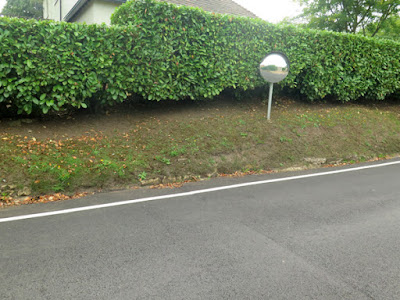 |
| Flaggy limestone on Harthill Road |
When I first visited Thorpe Salvin back in 1997, it was to undertake a survey of the roadside limestone quarry on Slaypit Lane, which is just a few hundred metres to the south of the village. I remember being very surprised at seeing a thin bedded limestone in the Cadeby Formation here, as well as it forming the foundations of the churchyard wall.
During my exploration of the architecture in the village in August 2020, having arrived along the path from Hawks Wood - where the limestones in the delph are also thin bedded - I came to a grassy bank on the south side of Worksop Road, where more thin beds of limestone are exposed near to the level of the road.
Walking further towards the centre of Thorpe Salvin, there are no obvious slopes or ridges in the road but, at the Parish Oven public house, there is a distinct slope that runs down to the junction of Harthill Road/Lady Field Road – with the churchyard occupying the corner site.
On both sides, it would appear that the road has been cut into a minor ridge of limestone, with no more than a metre of thin, irregular beds of rubbly limestone being exposed in various sections along the roadside cuttings.
The various sections of boundary walls here, which are built on and against these outcrops, use blocks with bed heights that are much greater those seen in the in situ exposures of limestone. As a leader of field trips with the Sheffield U3A Geology Group, I think that this would be a great stop on any guided tour of the village.
Looking at the various shapes and sizes of the individual stones here, it is quite clear that the underlying bedrock in Thorpe Salvin could not have been used for the boundary walls and houses. A little further down the slope, the Coronation Garden provides another example of the thinly bedded Cadeby Formation.
The section here has rubbly limestone, which may reflect desiccation and shrinkage, overlying massive limestone with well defined bedding planes. It reminds me of some of the sections that I have seen at Roche Abbey, where the mainly massive limestones of the Wetherby Member are interspersed with rubbly and honeycombed beds.
Continuing down Harthill Road, the churchyard wall and the boundary wall opposite are both built directly on flaggy limestone. Again, there is a great contrast between the thickness of the in situ beds and the building stones that have been placed on top of them.
Not having a microscope or access to any laboratories or institutions, I have never yet seen a thin section of dolomitic limestone from the Cadeby Formation, nor have I collected any rock samples from the very many exposures that I have visited; however, on the outcrop scale, it still holds many great surprises and I continue to learn about its variability in the field.









No comments:
Post a Comment